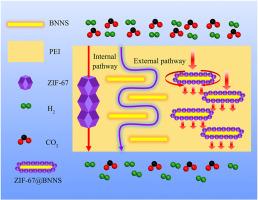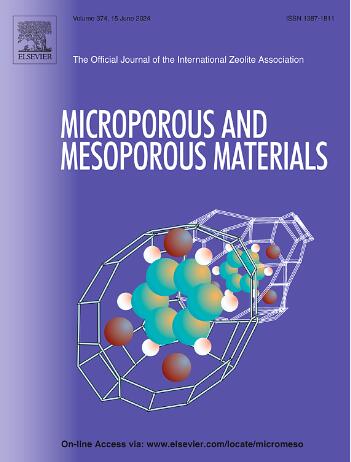Metal-organic framework/ 2D boron nitride nanosheets composite fillers in mixed matrix membranes for H2 /CO2 separation
IF 4.8
3区 材料科学
Q1 CHEMISTRY, APPLIED
引用次数: 0
Abstract
Nanometer-thick two-dimensional (2D) materials are becoming ideal fillers for designing mixed matrix membranes (MMMs) with high gas permeability and selectivity due to their unique structures. ZIF-67@BNNS composite fillers were prepared by combining boron nitride nanosheets (BNNS), a thermally stable and chemically inert two-dimensional material, with the metal-organic framework ZIF-67. By incorporating these materials into polyetherimide (PEI), MMMs with efficient hydrogen (H2) separation performance have been developed. The -NH2 groups on the BNNS surface provide a growth site for cobalt (Co) ions, facilitating the construction of a two-dimensional continuous channel by growing a ZIF-67 layer in situ on the BNNS surface. The inherent micropores of ZIF-67 create internal channels for gas transport within the composite packing, increasing gas permeability. The interlaced BNNS layer provides an external channel for gas transport, increasing resistance and contributing to improved gas selectivity. At a low loading of 1 wt%, the PEI/[email protected] MMMs exhibited a 199 % increase in H2 permeability and 87 % improvement in H2/CO2 selectivity compared to pure PEI membranes. In addition, these MMMs exhibit strong thermal stability and mechanical properties, making them promising for H2 separation applications.

用于 H2 /CO2 分离的混合基膜中的金属有机框架/二维氮化硼纳米片复合填料
纳米厚的二维(2D)材料因其独特的结构,正成为设计具有高气体渗透性和选择性的混合基质膜(MMM)的理想填料。通过将氮化硼纳米片(BNNS)这种热稳定性和化学惰性的二维材料与金属有机框架 ZIF-67 相结合,制备出了 ZIF-67@BNNS 复合填料。通过将这些材料与聚醚酰亚胺(PEI)结合,开发出了具有高效氢气(H2)分离性能的 MMM。BNNS 表面的 -NH2 基团为钴(Co)离子提供了一个生长位点,有利于通过在 BNNS 表面原位生长 ZIF-67 层来构建二维连续通道。ZIF-67 固有的微孔为复合填料内的气体传输创造了内部通道,从而提高了气体渗透性。交错的 BNNS 层为气体输送提供了外部通道,增加了阻力,有助于提高气体选择性。与纯 PEI 膜相比,PEI/[email protected] MMM 在 1 wt% 的低添加量下,H2 渗透率提高了 199%,H2/CO2 选择性提高了 87%。此外,这些 MMMs 还具有很强的热稳定性和机械性能,因此在 H2 分离应用中大有可为。
本文章由计算机程序翻译,如有差异,请以英文原文为准。
求助全文
约1分钟内获得全文
求助全文
来源期刊

Microporous and Mesoporous Materials
化学-材料科学:综合
CiteScore
10.70
自引率
5.80%
发文量
649
审稿时长
26 days
期刊介绍:
Microporous and Mesoporous Materials covers novel and significant aspects of porous solids classified as either microporous (pore size up to 2 nm) or mesoporous (pore size 2 to 50 nm). The porosity should have a specific impact on the material properties or application. Typical examples are zeolites and zeolite-like materials, pillared materials, clathrasils and clathrates, carbon molecular sieves, ordered mesoporous materials, organic/inorganic porous hybrid materials, or porous metal oxides. Both natural and synthetic porous materials are within the scope of the journal.
Topics which are particularly of interest include:
All aspects of natural microporous and mesoporous solids
The synthesis of crystalline or amorphous porous materials
The physico-chemical characterization of microporous and mesoporous solids, especially spectroscopic and microscopic
The modification of microporous and mesoporous solids, for example by ion exchange or solid-state reactions
All topics related to diffusion of mobile species in the pores of microporous and mesoporous materials
Adsorption (and other separation techniques) using microporous or mesoporous adsorbents
Catalysis by microporous and mesoporous materials
Host/guest interactions
Theoretical chemistry and modelling of host/guest interactions
All topics related to the application of microporous and mesoporous materials in industrial catalysis, separation technology, environmental protection, electrochemistry, membranes, sensors, optical devices, etc.
 求助内容:
求助内容: 应助结果提醒方式:
应助结果提醒方式:


